ZEN MESTEREK ZEN MASTERS
« Zen főoldal
« vissza a Terebess Online nyitólapjára
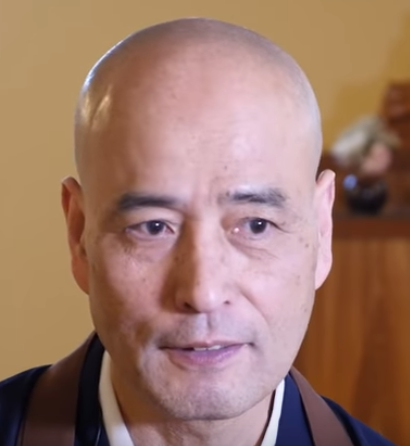
奥村正博 Okumura Shōhaku (1948-)
慈融正博 Jiyū Shōhaku
Tartalom |
Contents |
PDF: Zazen Instructions PDF: Dogen's Pure Standards for the Zen Community: PDF: Jijuyū-zanmai (“Samadhi of the Self”) by Menzan Zuiho Zenji. PDF: Dogen's Fukanzazengi 大智祖継 Daichi Sokei (1290–1366): 十二時法語 Juniji-Hogo The Way of Zazen (Zazengi) |
Shohaku Okumura (奥村正博 ; born June 22, 1948) is a Japanese Soto Zen priest and the founder and guiding teacher of the Sanshin Zen Community located in Bloomington, Indiana, where he and his family currently live. From 1997 until 2010, Okumura also served as Director of the Soto Zen Buddhism International Center in San Francisco, California, which is an administrative office of the Soto school of Japan.
Shohaku Okumura was born in Osaka, Japan in 1948. He received his education at Komazawa University in Tokyo, Japan, where he studied Zen Buddhism. On December 8, 1970, Okumura was ordained at Antaiji by his teacher Kosho Uchiyama Roshi, where he practiced until Uchiyama retired in 1975. He then traveled to the United States, where he co-founded Pioneer Valley Zendo in Massachusetts and continued Uchiyama's style of zazen practice there until 1981. In that year, he returned to Japan and began translating the writings of Uchiyama and Eihei Dogen from Japanese into English. Prior to founding the Sanshin Zen Community, in 1996, he was a teacher at the Minnesota Zen Meditation Center in Minneapolis, Minnesota, and at the Kyoto Soto Zen Center, in Japan.
Okumura has dedicated his life to zazen and to the study and translation of Dogen's writings. Among contemporary Zen teachers, he offers the unique perspective of a practitioner who is active in both the Japanese and Western Soto Zen communities, as well as insights that come from his translation work. The two main focuses of Okumura's teaching career have been sharing the zazen practice of his teacher Kosho Uchiyama and giving extensive commentaries on the works attributed to Dogen. In addition to sesshins, he leads four intensive study retreats (called genzo-e) each year, which are dedicated to particular fascicles of Dogen's Shōbōgenzō. These take place at Okumura's home temple, Sanshinji, at other American Zen centers, and occasionally outside the United States. The author James Ishmael Ford describes Shohaku Okumura as, “…a tireless worker bridging the gap between Japanese and non-Japanese practice communities.”
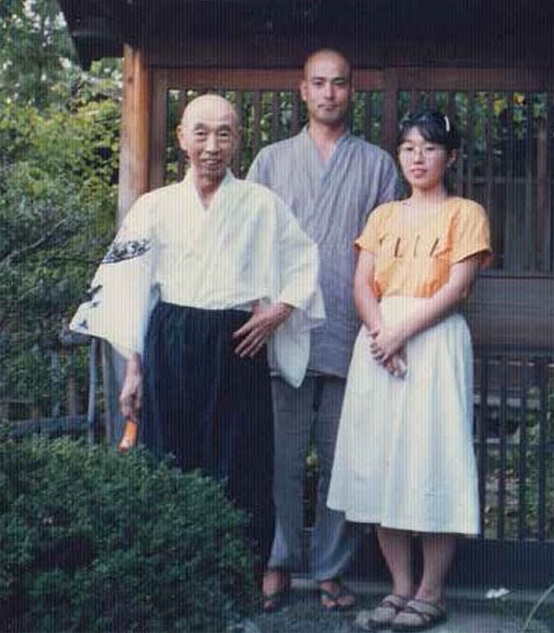
Shohaku Okumura with his master, Kosho Uchiyama and his wife, Yuko Okumura
https://www.lionsroar.com/profile-sanshin-zen-community/
http://sanshin.bandcamp.com/album/9-talks-on-shobogenzo-genjokoan
https://web.archive.org/web/20150108024933/http://sanshinji.org/books/
http://www.washingtonzen.org/readings.html
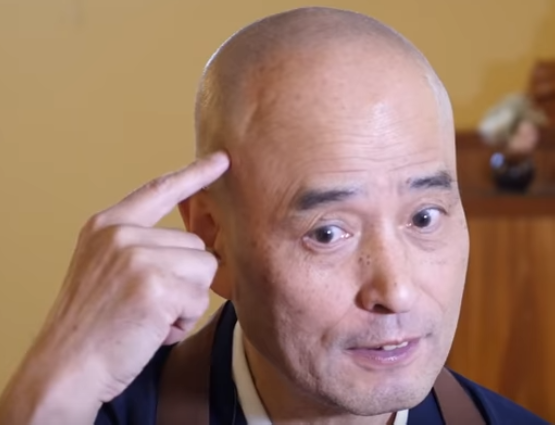
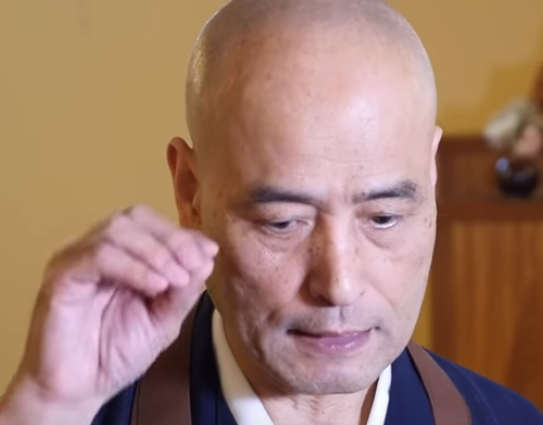
Shohaku Okumura: A Good for Nothing Life (1:27:42)
https://www.youtube.com/watch?v=jzdYzu2236Q
Abbot Shohaku Okumura was interviewed by Interior Mythos Journeys in April, 2017 at the Sanshin Zen Community.
Selected Bibliography
PDF: What Is Zen?: The Path of Just Sitting
in: A. Masuda and W.T. O’Donohue (eds.), Handbook of Zen, Mindfulness, and Behavioral Health, 2017, pp. 47-61
PDF: Living by Vow: A Practical Introduction to Eight Essential Zen Chants and Texts, by Shohaku Okumura, Wisdom Publications, 2012.
PDF: The Mountains and Waters Sūtra: A Practitioner's Guide to Dōgen's Sansuikyō
by Shohaku Okumura with contriburions by Carl Bielefeldt, Gary Snyder, and Isshō Fujita
PDF: Dogen’s Genjo Koan: Three Commentaries, by Eihei Dogen, Nishiari Bokusan, Shohaku Okamura and Shunryu Suzuki, Counterpoint, 2012.
PDF: Master Dogen’s Zazen Meditation Handbook: A Translation of Eihei Dogen's Bendowa [弁道話].
with a commentary by Zen Master Kosho Uchiyama Roshi
Tr. by Shohaku Okumura and Taigen Daniel Leighton
Boston: Tuttle Publishing. 1997.
Nothing Is Hidden : Essays on Zen Master Dogen’s Instructions for the Cook, by Eihei Dogen, Translated by Shohaku Okumura and Jisho Warner, Weatherhill, 2011.
PDF: Realizing Genjokoan, by Shohaku Okumura and Philip Shoryu Bradley, Wisdom Publications, 2010.
PDF: Dogen's Extensive Record: A Translation of the Eihei Koroku, by Eihei Dogen, Translated Shohaku Okumura and Taigen Dan Leighton, Wisdom Publications, 2010.
Soto Zen: An Introduction to Zazen, by Shohaku Okumura, Sotoshu Shumucho, 2006.
PDF: Opening the Hand of Thought: Foundations of Zen Buddhist Practice, by Kosho Uchiyama, Translated by Shohaku Okumura and Tom Wright, Wisdom Publications, 2004.
PDF: Dogen’s Pure Standards for the Zen Community: A Translation of the Eihei Shingi, Translated by Shohaku Okumura and Taigen Daniel Leighton, with forewords by Ikko Narasaki Roshi and Jusan Kainei Edward Brown, SUNY NY Press, 1996.
PDF: Heart of Zen: Practice without Gaining-mind
This book includs three important Soto Zen texts. The Gakudo-Yojinshu-
(Points to Watch in Practicing the Way) was written by Dogen Zenji, the
founder of the Japanese Soto School. The Jijuyu-Zanmai (Samadhi of the Self )
was written by Menzan Zuiho Osho, one of the greatest figures in the history
of Soto Zen. And, Dogen Zen as Religion was written by a contemporary Zen
master, Uchiyama Kosho Roshi.
PDF: Jijuyū-zanmai (“Samadhi of the Self”) by Menzan Zuiho Zenji. In Shikantaza: An Introduction to Zazen, edited and translated by Shohaku Okumura, Kyoto Soto-Zen Center, 1985
PDF: Dogen's Fukanzazengi Popular & Tenpuku Version translated by Shohaku Okumura
The Bodhisattva Precepts in Soto Zen Buddhism
Dharma Eye, February, 2004, No. 13.
http://global.sotozen-net.or.jp/pdf/dharma-eye/de13/de13_01.htm
Shobogenzo Zuimonki: Sayings of Eihei Dogen-Zenji recorded by Koun Ejo, translated by Shohaku Okumura, assisted by Daitsû Tom Wright
Kyôto Sôtô-Zen Center, 1987, 232 p.
Japan, Sotoshu Shumucho, 2004
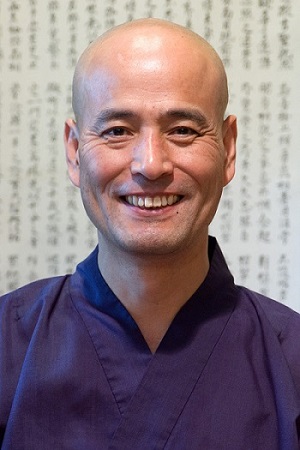
佛祖正伝菩薩戒 血脈
Busso shōden bosatsu-kai kechimyaku
Blood-vein of Bodhisattva Precepts Authentically Transmitted by Buddhas and Ancestors
(51) 永平道元大和尚 Eihei Dōgen Daioshō (1200-1253)
(52) 孤雲懐奘大和尚 Koun Ejō Daioshō (1198-1280)
(53) 徹通義价大和尚 Tettsu Gikai Daioshō (1219-1309) 1st Abbot of 大乗寺 Daijōji
(54) 瑩山紹瑾大和尚 Keizan Jōkin Daioshō (1268-1325) 2nd Abbot of Daijōji,
(55) 明峰素哲大和尚 Meihō Sotetsu Daioshō (1277-1350) 3rd Abbot of Daijōji
(56) 珠巌道珍大和尚 Shugan Dōchin Daioshō (?-1387) 4th Abbot of Daijōji
(57) 徹山旨廓大和尚 Tessan Shikaku Daioshō (?-1376) 5th Abbot of Daijōji
(58) 桂巌英昌大和尚 Keigan Eishō Daioshō (1321-1412) 6th Abbot of Daijōji
(59) 籌山了運大和尚 Chūzan Ryōun Daioshō (?-?) 7th Abbot of Daijōji
(60) 義山等仁大和尚 Gisan Tōnin Daioshō (1386-1462) 8th Abbot of Daijōji
(61) 紹嶽堅隆大和尚 Shōgaku Kenryū Daioshō (?-1485) 9th Abbot of Daijōji
(62) 幾年豊隆大和尚 Kinen Hōryū Daioshō (?-1506) 10th Abbot of Daijōji
(63) 提室智闡大和尚 Daishitsu Chisen Daioshō (1461-1536) Abbot of Daijōji
(64) 虎渓正淳大和尚 Kokei Shōjun Daioshō (?-1555) Abbot of Daijōji
(65) 雪窓祐輔大和尚 Sessō Yūho Daioshō (?-1576) Abbot of Daijōji
(66) 海天玄聚大和尚 Kaiten Genju Daioshō (?-?) Abbot of Daijōji
(67) 州山春昌大和尚 Shūzan Shunshō Daioshō (1590-1647) 19th Abbot of Daijōji
(68) 超山誾越大和尚 Chōzan Gin'etsu Daioshō (1581-1672) Abbot of Daijōji
(69) 福州光智大和尚 Fukushū Kōchi Daioshō (?-?)
(70) 明堂雄暾大和尚 Myōdō Yūton Daioshō (?-?)
(71) 白峰玄滴大和尚 Hakuhō Genteki Daioshō (1594-1670) Abbot of Daijōji
(72) 月舟宗胡大和尚 Gesshū Sōko Daioshō (1618-1696) 26th Abbot of Daijōji
(73) 徳翁良高大和尚 Tokuō Ryōkō Daioshō (1649-1709) Abbot of Daijōji
(74) 黙子素淵大和尚 Mokushi Soen Daioshō (1673-1746)
(75) 頑極官慶大和尚 Gangoku Kankei Daioshō (1683-1767)
(76) 興国素隆大和尚 Kōkoku Soryū Daioshō (?-?)
(77) 爐雪隆光大和尚 Rosetsu Ryūkō Daioshō (?-?)
(78) 雲外居山大和尚 Ungai Kozan Daioshō (?-?)
(79) 紹隆興法大和尚 Shōryū Kōhō Daioshō (1827-1912)
(80) 紹国禅興大和尚 Shōkoku Zenkō Daioshō (1864-?)
(81) 祖門興道大和尚 Somon Kōdō Daioshō (1880-1965) [沢木 老師 Sawaki rōshi]
(82) 道融興正大和尚 Dōyū Kōshō Daioshō (1912-1998) [内山 老師 Uchiyama rōshi]
(83) 慈融正博 Jiyū Shōhaku (1948-) [奥村 老師 Okumura rōshi]
On Takuhatsu
by Rev. Shohaku Okumura
Director, Soto Zen Buddhism International Center
(Edited by Koshin Steve Kelly)
Dharma Eye, February 2004, No. 13, pp. 12-15.[…]
Traditional practice of Dana in takuhatsu (begging)
In India, since the time of Shakyamuni Buddha, Buddhist
monks were required to relinquish the bonds with
their families, give up their livelihood and property and
live with three robes and one bowl. Monks begged in nearby
villages for food, eating only once a day before noon.
Their begging was a practice to be free from desire for
possessions and essentially from ego attachment. This
tradition still continues in the Theravada Buddhism in
South Eastern Asia. There are two sorts of offering in
Buddhism: the offering of materials and the offering of
Dharma. Lay people offer materials such as food, clothing
medicine and other requirements to monasteries or monks.
Also lay Buddhists offer things as charity to the needy
people in society. And monks offer Dharma, the spiritual
teachings they study and practice. Monks and laity support
each other through the practice of these two kinds of
offering (dana).Takuhatsu at Antaiji
In modern Japan, almost all Buddhist temples are
supported by temple members. Temple priests commonly
do not practice takuhatsu except on certain special
occasions. Only monks in training practice it while they
are living at a monastery. And usually people at this time
offer money instead of food, except when they do
takuhatsu specifically for rice or some vegetables.
During the time I was practicing at Antaiji, because
the temple had no members, our practice was supported
solely by our takuhatsu. We monks did it a few times a
month. We walked on the market streets in Kyoto, Osaka,
Kobe and other smaller cities and towns in the area. When
we did takuhatsu, 3 to 5 of us walked together. Since most
of us were in our early 20’s, it was fun, like taking a hike.
It was also very meaningful practice. At Antaiji, we
focused on zazen practice and Dharma study mainly of
Dogen Zenji’s teachings. When we practice in this way, we
tend to feel like we are living a much more meaningful and
higher way of life than the people who are working hard in
society to earn money day after day. We may even look
down on people by seeing them from our lofty position.
But when we practice takuhatsu, we are just beggars on the
street. We have a chance to see society from the bottom.
When doing takuhatsu we walk on the street wearing
the traditional monks’ black robe, straw sandals and a
bamboo hat. We hold a begging bowl (oryoki) and intone
“Hooo (It refers to hau, the begging bowl)” in a loud
voice. We usually stop in front of each house or shop on
the street for a short while until the shop owner or other
people give a donation or express their rejection with
words or a gesture. If no one is there or people do not
react, we continue on to the next shop.
When people make a donation, we recite the praising
verse of dana that says, “Zaiho nise kudoku muryo
danbaramitsu gusoku enman naishi hokkai byodo riyaku.
(The virtue of two kinds of offering; the offering of
materials and offering of Dharma, is boundless. The
Perfection of generosity (dana paramita) is completed and
it benefits all living beings in the entire dharma world.”
When we are rejected or ignored, we simply and sincerely
make a bow and walk to the next door.
Some people make a bow with gassho like they do to
the Buddha when they put their donation into our begging
bowl. Some people look down on us and put money in our
bowls like they would with a beggar. Some people shout,
“Go away!” Some people decline to make an offering by
saying, “I am sorry but -----.” Some people just ignore us.
Some people make fun of us. We encounter many different
reactions from many different people; rich, mediocre or
poor, tough, gentle or pious, etc. etc. We just see people’s
reactions and keep the same respectful attitude toward
everyone. We walk in this way about five to six hours a
day.
When we first go on takuhatsu, we are taught several
important principles of takuhatsu practice. The most
important point is to keep the same respectful attitude
toward all people. We should not skip any single house or
shop on the street. Whether rich or poor, kind or not kind,
we should not have any preferences toward people. We
should not change our attitude depending upon the
amount of donation or their way of treating us. We should
be mindful not to disturb people working at a shop, people
shopping or people walking on the street. Takuhatsu is a
practice of equanimity, freeing us from self-centeredness
and our discriminating minds. Through takuhatsu, our
practice is connected with everyone in society.
Takuhatsu as a koan
In my early 30’s while I was living on takuhatsu, I had
a question regarding this definition of dana by Dogen
Zenji. From 1981 to 1984, I lived in a small nunnery in
Kyoto as a care-taker. A friend of mine looks after the
temple and because he had another temple, he generously
allowed me to live there and practice. I also worked on
translation of Dogen Zenji’s and my teacher’s books from
Japanese to English with my American Dharma brother,
Daitsu Tom Wright. I had daily zazen and monthly 5-day
sesshin. Because I became a monk while I was a university
student studying Buddhism and Zen and entered a
monastery directly from school, I have no skills to make an
income at all. All I knew was zazen practice and some
knowledge of Zen Buddhism. But to be mature as a zazen
practitioner takes a really long time, and in my 20’s and
30’s, I felt I had nothing to offer anyone. A few times a
month, I practiced takuhatsu in the market streets in
Kyoto, Osaka, Kobe and other places just as I did while I
was at Antaiji. In that manner, I received approximately
30,000 Yen ($300), just enough income to keep my
practice and translation work going.
As I said before, when I practiced at Antaiji, I did
takuhatsu together with other monks. It was not difficult. I
enjoyed it like a hike. But doing takuhatsu alone was
completely different. I was often intimidated and felt as if I
was just a meaningless beggar.
Once I did takuhatsu alone in a market place in Osaka.
Osaka and Kyoto are quite different cities. In Kyoto, since
there are many temples and monasteries, people know
about takuhatsu and respect Buddhist monks. Osaka,
however, has been a city of merchants from the Tokugawa
era, and consequently there is much less sympathy for
monks. Actually, my family had been merchants in Osaka
for the last six generations, about 300 years, and I knew
the people’s attitudes towards monks there.
Once when I was begging, a boy about ten years old
asked me, “You want money, don’t you?” I thought what
he was really asking was whether I did takuhatsu for the
sake of Dharma, or for the sake of money to live on. I
could not give him an answer. It was a big and difficult
koan for me. If I didn’t need money, I would not do
takuhatsu. So, I could not say I did not want money. But,
if money was really what I wanted, there are much better
ways than takuhatsu to get it. Takuhatsu is not an easy way
to make money. It was hot in summer walking wearing
four layers of clothing – underwear, juban, kimono, and
koromo. In the winter, walking with bare feet and hands
was really hard practice. However, mentally it was even
more difficult. I often felt I was a meaningless, valueless
person in society and sometimes I really did not want to
go. There were days I felt so guilty living on alms I quit
begging and returned to the temple. I knew it would be
much easier to do some work to make money. At this time,
I thought of many good reasons to quit, not only
takuhatsu, but also being a monk. Takuhatsu practice
makes it very clear whether we do things for the sake of
Dharma or for the sake of ourselves.My question regarding Dogen’s definition of offering
Eventually my koan regarding Dogen Zenji’s definition
of dana became clear to me: by trying not to be greedy, I
felt like I had nothing to offer. As Sawaki Roshi taught,
zazen is good for nothing. Although I was working on
translation, Japanese people were naturally not interested
in English translations of Zen texts. I really felt I just
received money from people without offering them
anything. As I have said before, to be mature as a zazen
practitioner takes really a long time. As long as we are halfbaked,
zazen practitioners are really good for nothing.
Until we are quite ripe we are simply not edible, like an
astringent persimmon.
Because I wanted to live without greed, I did zazen and
takuhatsu. And because of that, I felt I had nothing to
offer. I simply received donations from people. I often felt
guilty. And my sense of unworthiness made me feel small
and ashamed. I thought that my condition was totally
contrary to Dogen Zenji’s definition of offering.
Ryokan the beggar
In my 20s, I wanted to live like Dogen Zenji and I
devoted myself completely to zazen practice. In my early
30s, I thought I could not live like Dogen anymore and
further I found that I didn’t want to do so. During that
period, Ryokan (1758-1831) became my hero instead of
Dogen. Ryokan was trained at a Soto Zen monastery and
received Dharma transmission from his teacher. But after
his teacher’s death, he never lived in a monastery or a
temple. He traveled all over Japan for many years and went
back to live in his home town. He built a hermitage on a
mountain and simply practiced takuhatsu. He never acted
like a Zen master. He wrote poems both in Japanese and in
Chinese, made calligraphy, and played with children while
on his begging rounds.
Ryokan also wrote many poems about his takuhatsu.
When children found Ryokan doing takuhatsu in their
village, they gathered together around him and urged him
to play with them. Ryokan often did so and forgot about
begging. Ryokan’s famous waka poems on takuhatsu show
his attitude.
Playing ball
With the children in this village
Spring day, never let the shadow fall!I was on my way to beg
But passing by a spring field
Spent the whole day
Picking violets.In my begging bowl
Violets and dandelions are mixed together
Let’s make an offering
To all the buddhas in the three times.
On a spring day, while he was doing takuhatsu, children
asked him to play with them. Ryokan played with the
children tossing a ball or picking the wild spring flowers in
the field. Sometime he forgot about takuhatsu completely.Oh! My poor begging bowl!
I left it behind
Picking violets by the roadside.
I left my begging bowl behind
And yet no one took it.
No one took it! my poor begging bowl!
(Translations of poems by Abe Ryuichi and Peter Haskel, Great
Fool - Zen Master Ryokan, University of Hawaii Press, Honolulu,
1996, with minor changes by the author).
My takuhatsu was not like Ryokan’s. I never played
with children. During the day time I did takuhatsu,
children were in school except Sundays. At Ryokan’s time,
there were no schools or daycare for the children in a
farming village. Playing with children was Ryokan’s
offering.
Also, to me, takuhatsu was the way to support my
zazen practice and translation work. I needed to do
takuhatsu efficiently. Otherwise, I lost my time to sit and
work on translation. I tried to do takuhatsu only a few
times a month; just enough to support my practice. But for
Ryokan, takuhatsu was not a method to support his
practice. Takuhatsu itself was his practice.
“In my begging bowl / Violets and dandelions are
mixed together / let’s make an offering / to all the buddhas
in the three times”.
Here, the begging bowl used to receive offerings from
people became a container to make offerings of flowers
from the spring fields to all buddhas in the past, present
and future. This is because Ryokan has no desire to get
anything for himself. Ryokan was completely free from any
greed to gain anything for his own sake. His takuhatsu,
playing with children, and talking with the villagers were
all his offering. And even after his death, his way of life
itself was an offering to people in later generations. Many
people have been inspired and encouraged by his way of
life.
Although this poem is without a title, I am pretty sure
Ryokan wrote it about his takuhatsu.With no-mind, the flower invites a butterfly
With no-mind, the butterfly visits the flower
When the flower opens, the butterfly comes
When the butterfly comes, the flower opens
I am the same
I do not know the people
And the people do not know me
Without knowing
We follow the heavenly emperor’s law.I understood through Ryokan that receiving an offering
can itself be an offering only when it is done without
selfish concern. Once while I was begging in Kobe, a
middle aged man riding a bicycle stopped in front of me
and offered a 1,000 yen (about $10) bill, an exceptionally
large donation to receive for takuhatsu, saying, “My wife
died a few days ago, this offering is for her.”
During takuhatsu, we don’t speak much with people,
but in this encounter without words, I felt a deep and
powerful communication. I felt the virtue of takuhatsu was
not only for me but also for the people making the
offering. To receive offerings, I had to keep my attitude
toward life free from my selfishness. I had to live and
practice for the sake of Dharma, not for myself personally.
To keep this attitude is extremely difficult. Doing
takuhatsu is a hard yet wonderful practice to examine one’s
way of life and life in society. This is a terribly difficult
koan.
In studying Dogen Zenji’s definition of “Offering is
not to be greedy”, I found a deeper meaning of offering.
We exist only within the network of offering. We receive
offerings from air, water, plants, animals, mountains and
rivers and people. Our practice of offering is just to keep
this cycle of offering circulating instead of only receiving
and using it to satisfy my personal desires. The spring
flower offers nectar to the butterfly. The butterfly carries
pollen for the flower. Each are helping and supporting
without calculating how much they get as a reward. To
keep the network of interconnected origination pure is the
true meaning of practicing Dana paramita. We really don’t
need to gain things in order to offer them to others. The
way of living without greed is itself an offering. The best
example of this was Shakyamuni Buddha’s life. He gave up
his position as a prince and all family wealth and became a
beggar. That was the greatest offering. Not because
someone else could get his position and wealth but that
people after him could study his example that we can live
without greed. This is what Dogen says in the second
paragraph of Shobogenzo Shishobo: “When the Way is
entrusted to the Way, we attain the Way. When we attain the
Way, the Way unfailingly continues to be entrusted to the
Way. When material things are treasured, these treasures
actually become dana.”